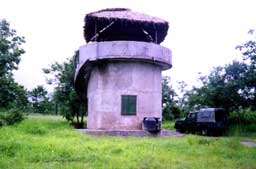COMPARTMENT NUMBER
The entire forest area is divided into small units called compartments
for administrative convenience. 3-4 compartments form a Beat controlled by a
forester. 3-4 rounds form a Range controlled by a Range controlled by a
Range Forest Officer and so on.

KANCHAN FIRE LINE
Here you are looking at the 5 km long Kanchan Fire Line which is
maintained to restrict unexpected fire from spreading from one end to
another during the dry hot summer. A fire line is created by cutting grass
and all shrubs from a sufficient width which varies from 6 metres to 12
metres. The strips are then burnt before February every year.
Panna National Park has a network of such fire lines. If you find any sign
of fire in the park, report it to your nearest of.

BADAMI BABA
He was a sage from the Pipartola village and was killed by a Tiger at
this spot. Because of the sanctity of the spot people do not fell trees
here.
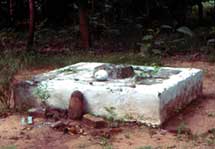
BARADARI
Just across the Ken river you can see a Baradari which was built by the
Chandelas. Behind it is the Raipura village of Chandranagar range.
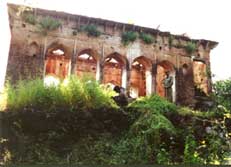
BHOURA DAU
Ken river flows deep here, occasionally creating a strong whirlpool. If
you are lucky you may spot a Mugger or a Ghariala, basking on the banks.
Fifteen young Gharials, bred in captivity in Chambal, have been released at
this spot in the year 1996 to replenish the natural stock. Being a perennial
water body, this place is a favourite watering point for all kinds of
animals, including the tiger in hot summer.
The big Kahua (Terminalia arjuna) tree in front on the river bank, is
here since ages. Elsewhere kahua provides tanins and medicines, besides good
timber. However, here in the National Park like herons, egrest, ibis,
darter, etc., when they migrate here during November to February, besides
providing a cool safe place for honey bees to make their beehives.
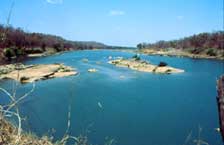
KULLU
Kullu tree is also called the ghost of the forest. This tree has a very
prominent shining bark. The bark changes its colour in different seasons.
The white bark and leafless in the dry season gives the tree a ghost like
appearance. The tree yields gum which has medicinal importance. It flowers
in the month of March.
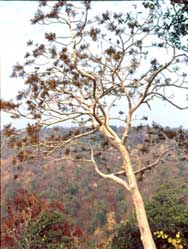
The forests of Panna were the shooting reserves of the erstwhile rulers
of Panna, Chattarpur and Bijawar states. During game hunting the shooter
used to sit in such "gadhas" protecting himself from any possible
animal attack and through "hakka" the game was driven towards
gadha so that the shooter could shoot.
CHEWLA JHARIA
Water is a natural resource essential for the existence of all life. In
Panna the water sources are the Ken river and nalas which are natural
sources whereas check dams and anicuts are manmade. Well distributed water
sources all over the protected area enables wild animals to use most parts
of forests and crowding of large numbers of wild animals in one place is
avoided.
MAGRA DABRI
The black stones that you are seeing are known as 'Shales' and are an
important geological feature of Panna. During monsoon, at times the water
reaches the spot where you are now standing and in summer it receds down.
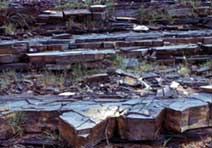
QUALA
Place of worship where "Asmani Mahakali" puja is performed
during Deepawali.

PIPARTOLA
The colourful stones that you are seeing here are known as Pipartola
conglomerate which has pebbles of red jaspar. One stone was taken from this
place to be placed at "Shakti Sthal " at Delhi, the memorial of
Late Mrs. Indira Gandhi.
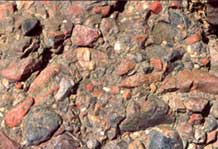
KARDHAI PATCH
This place is called the Silata valley and it has a pure patch of
Kardhai (Anogeissus pendula). In Panna it is eastern most boundary of
Kardhai forests. The species is found on rocky ground with shallow soil.

DHUNDHWA SEHA
The nalas or the small rivers originating from the plateau
generally make falls locally called "Seha" and thereafter valley
are formed. When the water falls from a height the gorge gives a misty look
thus the name Dhundwa or misty. The gorge forms ideal habitat for animals
during summer. Look out for vultures in the rock crevices evident with the
white colour of their droppings.
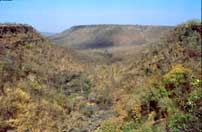
GRASSLAND
Nature has favoured creation of grasslands to provide food and
shelter for herbivores, birds and insects. Grasses also provide a very good
stalking cover for the predators to catch their prey. Grasslands support a
rich diversity of micro flora and fauna. Grasslands, therefore are not
forest but are highly productive and rich part of the protected area
ecosystem. Look out for Chausingha, Chinkara, Nilgai and Sambar.
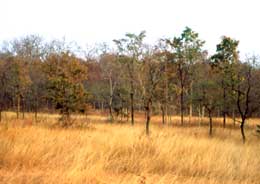
MAHUA PANI WATCHTOWER
Mahua Pani watchtower offers a vantage point to observe and study
animal behaviour and also lookout for sign of fire. Bird watchers and
photographers can sit here for observing and photographing. You need to dit
absolutely quite and still, to listen to the music of the forest.
